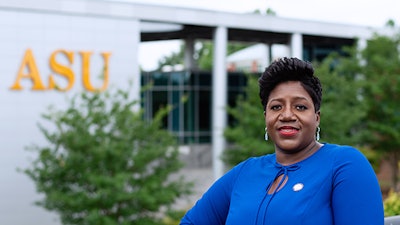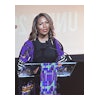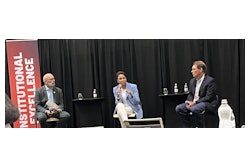Albany State University recently announced its president, Dr. Marion Ross Fedrick, had been appointed executive vice president for administration and chief of staff at Georgia State University, effective July 1. Her departure from the university meant she would step away from her role as president one year before the conclusion of the school’s 2025 strategic plan.
 Dr. Marion Ross Fedrick
Dr. Marion Ross Fedrick
Fedrick’s departure is just the latest in a series of presidential or leadership turnovers across the nation’s 105 historically Black colleges and universities (HBCUs). Since 2022, at least 35 HBCUs have announced presidential changes. While some scholars are deeply concerned by this instability, others note it aligns with higher education trends overall.
In 2023, the American Council on Education (ACE) released their study of over 1,000 college presidents, which revealed the tenure of the presidency has diminished. In 2006, presidents spent an average of 8.5 years in charge. By 2022, that number shrunk to 5.9 years, and over half of current presidents reveal that they plan to step away from their roles within the next five years.
The role of president is tough to begin with and getting only tougher. Just ask Dr. Walter M. Kimbrough, executive in residence at the University of South California’s Race and Equity Center, president in residence at The Rutgers Center for Minority Serving Institutions, and former president of two HBCUs: Philander Smith College in Little Rock, Arkansas, and Dillard University in New Orleans, Louisiana.
“The job is continuing to change in terms of the complexity. Social media has changed how so many things operate. You have people around the world who want to comment on your campus, and they don’t have a clue,” says Kimbrough. “It’s always been a hard job, but now social media is able to distort what the truth is. There isn’t any good training for that; you have to learn on the job, and that’s hard.”
Challenging times
Since the beginning of the 2022-23 academic year to today, over two dozen HBCUs have announced the retirement or departure of their executive. But what connects these turnovers? HBCUs are not a monolith, as each institution has their own distinct culture and climate. Most have notoriously low financial resources after over a hundred years of discriminatory legislation and policies. Some experts say that frequent leadership changes at HBCUs are due to misunderstandings between academic search firms and the HBCUs they represent, while others say that HBCUs’ boards of trustees, often the final say in leadership decision, don’t listen to the advice of search firms and select inappropriate candidates.
While many experts agree that HBCU presidential vacancies are simply part of a larger problem in higher education overall, most agree that frequent presidential turnover can negatively impact not only a university’s standing, donations, and accreditation but the everyday students’ life. Experts say that faculty, administration, alumni, and even current students have a role to play in influencing the stability of their university’s executive office. By gathering together and vocally expressing concern at rapid turnover, experts say, HBCUs can help turn the tide of presidential terminations.
Dr. William Broussard, vice chancellor of university advancement at the University of Wisconsin—Stevens Point, has been studying HBCU presidential turnover for 10 years.
 Dr. William Broussard
Dr. William Broussard
When Broussard began maintaining a list of presidential turnovers, he was working as director of athletics at Southern University and A&M College, an HBCU in Baton Rouge, Louisiana. During his five and a half years there, Broussard said, he worked for four different people under five different titles.
“Literally every time I twisted my chair around, there was a new person. The person who hired me had very specific goals, and then the next person had virtually the opposite goals,” says Broussard. “As a middle manager, managing the middle staff with experiences that are whipsawing in the wind, the ultimate victim of that is the students who are seeing the goals, ideas, and what they want to accomplish being bandied about.”
Some HBCU turnovers are the result of retirement, like Dr. Glenda Baskin Glover, who announced her departure from Tennessee State University after serving as its leader for over a decade. Other turnovers occur with surprising regularity, like at Arkansas Baptist College, where Dr. Calvin McFadden, Sr., announced his resignation after just one year of service.
Different standards?
Dr. Terrell L. Strayhorn, a professor in the school of education and director of the Center for the Study of HBCUs at Virginia Union University, says that at least one-fifth of the entire HBCU sector is now led by “acting, interim, or otherwise temporary leaders.”
But Strayhorn says he is not too concerned about HBCU presidential turnover, because it mirrors what’s happening at other, predominantly white institutions (PWIs) like Indiana State, Stanford University, and Broward College.
“Some change or turnover at the senior-most level of higher education leadership should be expected. It’s a tough job. People who are good at it sometimes get exciting, new opportunities to scale their work elsewhere,” says Strayhorn. “Those who do it for a long time run the risk of burnout and may need time to recharge, refresh, and redirect during an intermission. And it’s unwise, unhealthy, and unproductive to hang on to poor leadership, regardless of type of institution — turnover is a means of resetting strategically and charting a new sustainable path.”
Still, Strayhorn acknowledges that “the consequences of early, unexpected, or untimely departures can be significant.”
“[Early departure] can disrupt implementation of strategic plans that ensure business continuity and future growth planning. It can halt, stall, or break up budding partnerships with leading industries, investors, and other benefactors,” says Strayhorn. “It can also destabilize a leadership team, which can have ‘ripple effects’ elsewhere throughout the organization.”
Finding the right president, one who can stay on for the long haul, often requires the matchmaking expertise of academic search firms. But Dr. Dakota Doman, former interim CEO at Texas Southern University, an HBCU in Houston, Texas, believes that many presidential searches fail before they even begin. Some search firms, Doman says, do not take the necessary steps needed to fully understand the environment at the HBCU they are working with.
“Sometimes the institutions are just using the wrong partners to go out and find a good fit for that community,” says Doman. “I’ve heard from board members and presidents that they were being recruited under false pretense. The environment wasn’t what was described.”
Doman believes his search firm, TM2 Executive Search, where he serves as managing principal, is the answer. The firm started independently in 2016 and is now The Official Educational Talent Search subsidiary of the Thurgood Marshall College Fund (TMCF), which supports public HBCUs and primarily Black institutions (PBIs). Doman says that, by focusing specifically on serving HBCUs and PBIs, TM2 is able to better understand their unique needs and, therefore, find longer-serving fits for leadership roles.
 Dr. Walter M. Kimbrough
Dr. Walter M. Kimbrough
The goal, Doman says, is that each president they place receives a renewal offer on their contract and that they can stay for at least three to five years.
“Students should graduate under you,” says Doman. “If not, that tells us things didn’t go as well as we’d like them to go.”
Responding to the need
Dr. Herman Felton, president of Wiley College, an HBCU in Marshall, Texas, and former president of the HBCU, Wilberforce University in Wilberforce, Ohio, has been working to build and maintain a pipeline of HBCU leadership candidates through the co-founding of the Higher Education Leadership Foundation (HELF), which works to train and prepare talented and ambitious scholars for these highly taxing roles.
“It’s not about the work you bring to the presidency, it’s largely in part about how you are able to understand cultural pluralism at these complex organizations — and prideful organizations — understanding that the different tagline does not mean deficient,” says Felton.
HBCU presidents who have attended or worked at an HBCU have a longer tenure than those that don’t, says Felton. And past and current HBCU presidents are critical to making HELF and its mission successful, he adds. These seasoned leaders are able to be generalists, guiding aspirational leaders through the actualities of the president. HELF also brings in search firm representatives so future candidates can be prepared “to actually go into a search,” says Felton, “getting people to understand and curate relationships with firms, making sure you don’t have a reputation of jumping into each and every search, and how you can be an attractive candidate.”
“I don’t think people understand the depth of vetting that occurs — I certainly did not. I didn’t know, in my first presidency, that my credit would be run. The off-paper references, the triangulation that occurs, is real,” says Felton.
It’s not just the candidates and their preparedness that matters. Broussard notes that “meddlesome boards” can be a root cause for presidential turnover. Public boards are often appointed by the state government, while private boards can be appointed by religious denomination, says Broussard. Regardless, there is an equal opportunity for boards to “get over-involved, make decisions that impact the day to day, that do not give the campus executive the true opportunity to run the institution,” says Broussard.
“For presidents or executives who do not want to deal with that, they may shorten their term and leave,” says Broussard.
Boards most often have the final say in an institution’s presidential nomination and vote for approval of any new leader. Some boards do not contain members with educational experience, or contain politically appointed members. Some boards make completely independent leadership decisions and disregard search firm recommendations, says Kimbrough. That’s why he, Broussard, and others agree that faculty, alumni, and even students should be able to vocalize their concerns about frequent leadership changes.
“If there is a lot of turnover, faculty and alums need to ask, ‘what’s going on with us?’” says Kimbrough. “They have to be vocal, and I don’t know if enough of that happens, or if people feel empowered to do that.”
No matter the institution, Kimbrough adds, that sincere introspection needs to take place, not only within boards but within those who seek the presidency.
“I had a short-term president once tell me, ‘[the presidency] isn’t being in a fishbowl, it’s a shark tank.’ Between politics and social media all together, it can be rough — you gotta have a different mindset now than 20 years ago,” says Kimbrough. “Are you willing and able to be in the shark tank?”



















